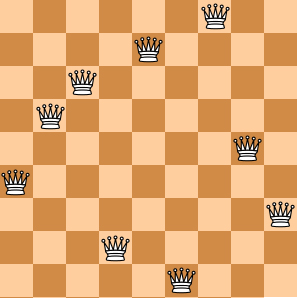释放无限光明的是人心,制造无边黑暗的也是人心,光明和黑暗交织着,厮杀着,这就是我们为之眷恋又万般无奈的人世间。
The "eight queens puzzle" is the problem of placing eight chess queens on an 8×8 chessboard so that no two queens threaten each other. Thus, a solution requires that no two queens share the same row, column, or diagonal. The eight queens puzzle is an example of the more general N queens problem of placing N non-attacking queens on an N×N chessboard. (From Wikipedia - "Eight queens puzzle".)
Here you are NOT asked to solve the puzzles. Instead, you are supposed to judge whether or not a given configuration of the chessboard is a solution. To simplify the representation of a chessboard, let us assume that no two queens will be placed in the same column. Then a configuration can be represented by a simple integer sequence (Q1,Q2,⋯,QN), where Qi is the row number of the queen in the i-th column. For example, Figure 1 can be represented by (4, 6, 8, 2, 7, 1, 3, 5) and it is indeed a solution to the 8 queens puzzle; while Figure 2 can be represented by (4, 6, 7, 2, 8, 1, 9, 5, 3) and is NOT a 9 queens' solution.
 |
 |
|
|---|---|---|
| Figure 1 | Figure 2 |
Input Specification:
Each input file contains several test cases. The first line gives an integer K (1<K≤200). Then K lines follow, each gives a configuration in the format "N Q1 Q2 ... QN", where 4≤N≤1000 and it is guaranteed that 1≤Qi≤N for all i=1,⋯,N. The numbers are separated by spaces.
Output Specification:
For each configuration, if it is a solution to the N queens problem, print YES in a line; or NO if not.
Sample Input:
4
8 4 6 8 2 7 1 3 5
9 4 6 7 2 8 1 9 5 3
6 1 5 2 6 4 3
5 1 3 5 2 4
Sample Output:
YES
NO
NO
YES#include <iostream>
#include <cstdio>
#include <algorithm>
#include <string>
#include <cstring>
#include <cstdlib>
#include <cmath>
#include <stack>
#include <queue>
#include <set>
#include <map>
#include <vector>
#include <ctime>
#include <cctype>
#include <bitset>
#include <utility>
#include <sstream>
#include <complex>
#include <iomanip>
#include<climits>//INT_MAX
//#include<bits/stdc++.h>
#define PP pair<ll,int>
#define inf 0x3f3f3f3f
#define llinf 0x3f3f3f3f3f3f3f3fll
#define dinf 1000000000000.0
#define PI 3.1415926
typedef long long ll;
using namespace std;
int const mod=1e9+7;
const int maxn=1010;
int s[maxn];
int i,j,k,K,N;
int main()
{
scanf("%d",&K);
while(K--){
scanf("%d",&N);
bool fg=0;
for(i=1;i<=N;++i)
scanf("%d",&s[i]);
for(i=1;i<=N;++i){
for(j=1;j<=N;++j){
if(i!=j){
if(s[i]==s[j]||(abs(s[i]-s[j])==abs(i-j))){
fg=1;
break;
}
}
}
if(fg)
break;
}
if(fg)
printf("NO\n");
else
printf("YES\n");
}
return 0;
}